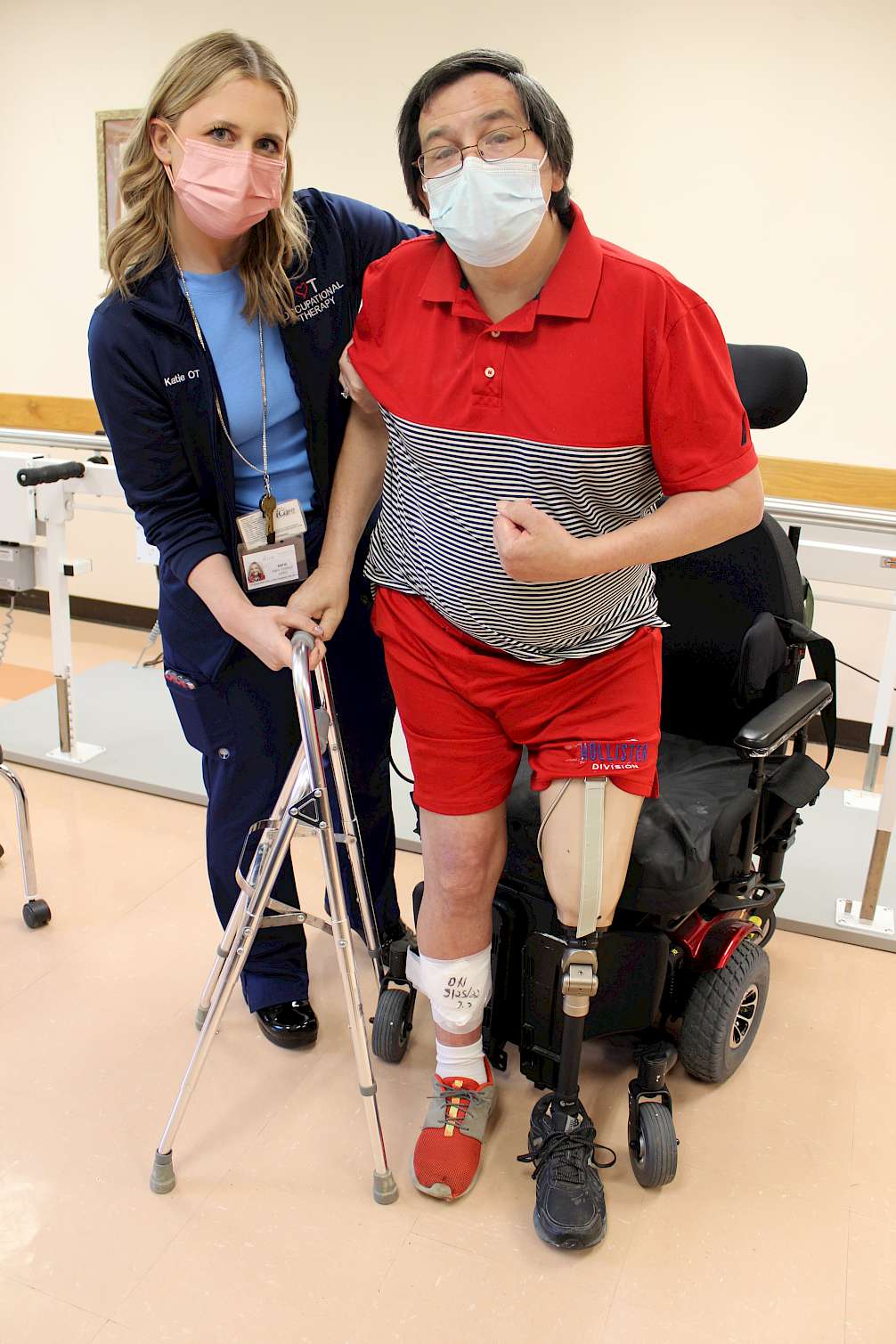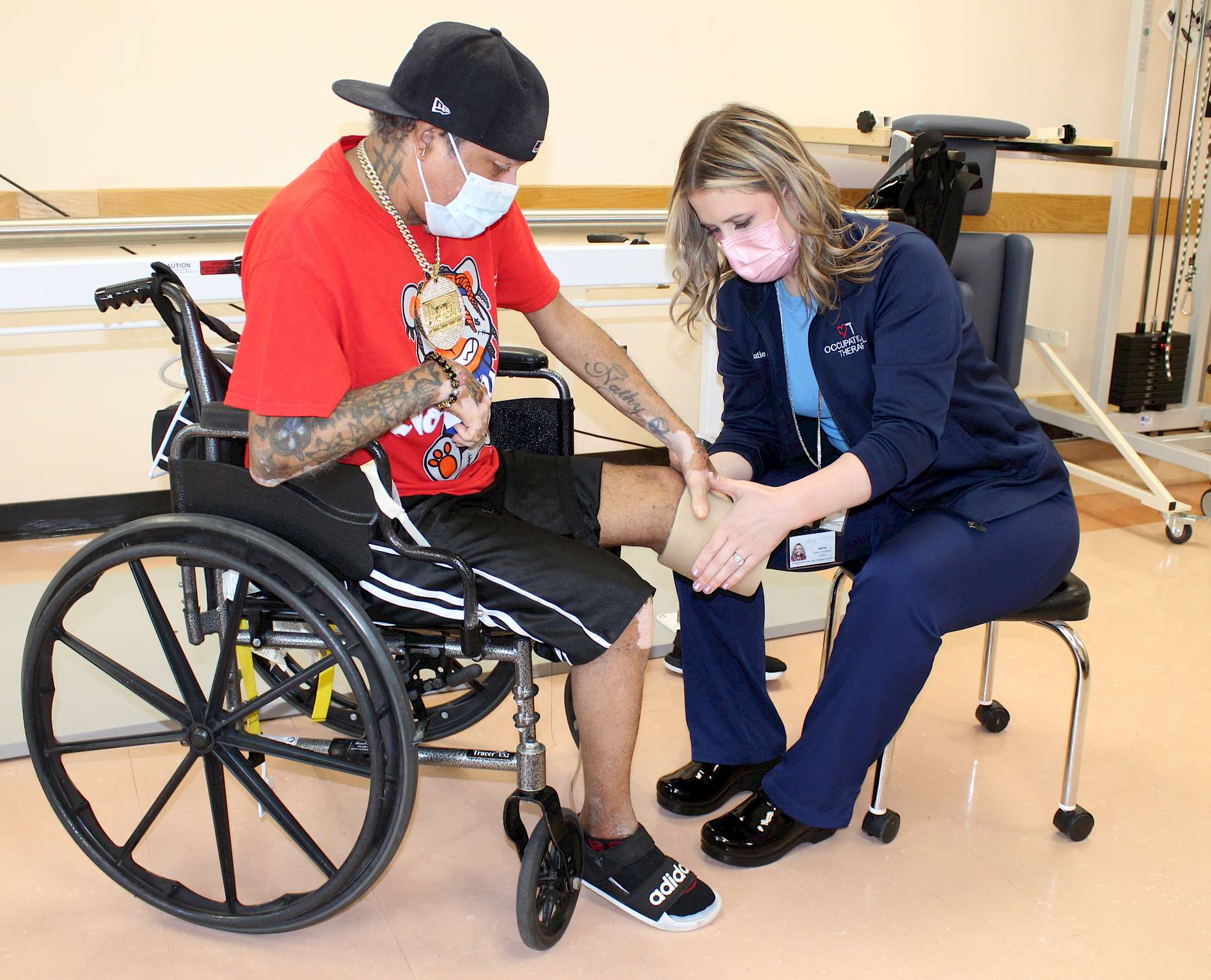Program Overview
Parkville Care Center is excited to introduce a post-amputation, limb loss program to its existing lines of clinical service. The program is designed to holistically treat the patient and their family through the pre and post stages of limb loss and amputation rehabilitation.
Disciplines involved include Rehabilitation Services, Nursing, Social Services, and Nutrition Services and are supported by a consulting physician, mid level providers, wound care consultants and prosthetic and orthotic specialists.
The program entails four phases of the process for residents with new limb loss: Pre-Procedure, Post Procedure Wound Care/Pain Management, Pre-Prosthetic Training and finally Prosthetic Training. Thos with existing limb loss will have all of the same critical services and supports available to them but in a long term maintenance and functional improvement model.
Physician Specialist and Program Consultant
Coming Soon!
Pre-Procedure
Prior to hospitalization, the patient and family will visit the Care Center. A tour of the Care Center will be given and the patient will be introduced to the therapists who will be working with them during their stay. It will also be an opportunity to sit with the Care Center LCSW to go over psychosocial concerns regarding the procedure and its effect on body image and overall self-esteem. Family caregivers will be invited to participate. Parkville hopes to have “peer supports” patients who themselves are involved in the process and can speak first hand to the process and goals. Patients will be able to participate in an in-house Pre-Hab program through Touchpoints Therapy where they work with the therapists, prior to the procedure, to strengthen the limbs prior to the procedure.
Post Procedure Wound Care/Pain Management
This stage marks the beginning of post-hospitalization care. The goals of this stage are pain management and wound healing. Pain management will utilize both pharmacologic and other modalities. Therapy modalities such as the Hivamat and the Tense unit are highly effective in reducing pain and sensitivity. Therapy will also be involved in assuring that no contractures develop and working on balance and transfer training. The stump wound will be evaluated regularly by the Care Center’s wound care nurse and APRN. Frequent visits by the LCSW will occur to help the patient and family adapt to the new body image and coping with limb loss.
Pre-Prosthetic Training
Wound closure marks the beginning of the next chapter. During this period the residual limb will be formed with the aid of a sh rinker or compression stocking. Therapy will use a variety of modalities to assist in the desensitization of the remaining limb. Therapists will also work with patient on gaining independence in bed to chair mobility, balance, and transfers. The prosthetist will take measurements and begin fabrication. Nutritional counseling will be on-going. Emphasis will be placed on weight management, and diabetes education where appropriate.
rinker or compression stocking. Therapy will use a variety of modalities to assist in the desensitization of the remaining limb. Therapists will also work with patient on gaining independence in bed to chair mobility, balance, and transfers. The prosthetist will take measurements and begin fabrication. Nutritional counseling will be on-going. Emphasis will be placed on weight management, and diabetes education where appropriate.
Prosthetic Training
The delivery of the prosthesis marks the next phase of the process. The therapist will work with the patient and family on how to don and remove the device. Therapy will continue to work on walking on uneven surfaces, car transfers, and stairs. The LCSW will continue to meet to ensure that feelings of grief or loss are managed.
Discharge Planning and Community Care Transition
The final step of the process involves ensuring that there is a seamless transition home. A home visit is often times encouraged to ensure that the physical layout of the home environment is conducive to a safe transition. Recommendations for additional equipment or renovations will be made at this time. A face to face meeting with representatives of Touchpoints at Home can occur at this time to ensure all are in agreement with the next goals of care.
Collaboration
The interdisciplinary team at Parkville Care Center will collaborate on the patient centered care plan. This team includes:
- Orthopedic Surgeon
- Vascular Surgeon
- Podiatrist
- Wound Nurse and Parkville nursing team
- Physical and Occupational Therapists
- Medical Director, physician staff and/or APRN
- Prosthetics and Orthotics Providers
- Therapeutic Recreation and Social Work team
Tools for Success - Rehabilitation Equipment
The following therapy modalities are integral to the program:
- Electrotherapy TENS unit
- HIVMAT
- Sit to Stand NeuroGym
- Neuro Gym Mobility Trainer
- Power Height/Width Parallel Bars
- Hydroculator and Diathermy
- Lymphedema Cards
- Walkers and Wheelchairs
- Specialty Slideboards
- In-house Wound Vac
- Wound Camera
Nursing and Therapy Education
Nursing and Therapy professionals at Parkville have received specialized training on the following topics:
- Proper positioning of a limb following an amputation
- Falls risk management
- Signs of developing contractures and assessment tool
- Donning and Removal of Prosthesis
- Wound Care, Healing and Dressing
- Assessment of developing complications
- Transfers and Mobility
- Assessing Weight Bearing Status
- Nutrition and Portioning Education
- Smoking Cessation Education
- Pain Management to include:
- Non-verbal indicators of pain
- Non pharmacological pain remedies
Descripción general del programa
El Programa de Pérdida de Extremidades en Todas las Fases de Parkville está diseñado para tratar holísticamente al paciente y su familia a través de las etapas previas y posteriores de la rehabilitación de la amputación.
El programa incluye cuatro elementos clave: Pre Procedimiento, Post Procedimiento Cuidado de Heridas / Manejo del Dolor, Entrenamiento Pre-Protésico y finalmente Entrenamiento Protésico.
Pre Proced imiento
Antes de la hospitalización, el paciente y la familia visitarán el Centro de Atención. Se dará un recorrido por el Centro de Atención y se presentará al paciente a los terapeutas que trabajarán con ellos durante su estadía. También será una oportunidad para sentarse con el Centro de Atención LCSW para repasar las preocupaciones psicosociales con respecto al procedimiento y su efecto en la imagen corporal y la autoestima general. Se invitará a los cuidadores familiares a participar.
Parkville espera tener pacientes de “apoyo de pares” que estén involucrados en el proceso y puedan hablar de primera mano sobre el proceso y los objetivos. Los pacientes podrán participar en un programa interno de Pre Hab a través de Touchpoints Therapy donde trabajan con los terapeutas, antes del procedimiento, para fortalecer las extremidades antes del procedimiento. (Pendiente delestado de la licencia para pacientes ambulatorios)
Cuidado de heridas posterior al procedimiento y manejo del dolor
Esta etapa marca el comienzo de la atención posterior a la hospitalización. Los objetivos de esta etapa son el manejo del dolor y la cicatrización de heridas. El manejo del dolor utilizará tanto las modalidades farmacológicas como otras. Las modalidades de terapia como hivamat y la unidad TENS son altamente efectivas para reducir el dolor y la sensibilidad. La terapia también estará involucrada en asegurar que no se desarrollen contracturas y trabajar en el entrenamiento de equilibrio y transferencia. La herida del muñón será evaluada regularmente por la enfermera de cuidado de heridas del Centro de Atención y APRN. Las visitas frecuentes del LCSW se llevarán a cabo para ayudar al paciente y a la familia a adaptarse a la nueva imagen corporal y hacer frente a la pérdida de extremidades.
Entrenamiento Pre Protésico
El cierre de la herida marca el comienzo del siguiente capítulo. Durante este período, el muñón se formará con la ayuda de un reductor o media de compresión. La terapia utilizará una variedad de modalidades para ayudar en la desensibilización de la extremidad restante. Los terapeutas también trabajarán con el paciente para ganar independencia en la cama para la movilidad de la silla, el equilibrio y las transferencias. El protésico tomará medidas y comenzará la fabricación. El asesoramiento nutricional será en curso. Se hará hincapié en el control del peso y la educación sobre la diabetes cuando sea apropiado.
Entrenamiento protésico
La entrega de la prótesis marca la siguiente fase del proceso. El terapeuta trabajará con el paciente y la familia sobre cómo ponerse y quitar el dispositivo. La terapia continuará trabajando en caminar sobre superficies irregulares, traslados de automóviles y escaleras. La LCSW continuará reuniéndose para garantizar que se manejen los sentimientos de dolor o pérdida.
Planificación del alta y transiciones de atención comunitaria
El paso final del proceso implica garantizar que hay una transición perfecta a casa. Un hogar a menudo se recomienda la visita para garantizar que el
el diseño físico del entorno del hogar es propicio para una transición segura. Recomendaciones para equipos adicionales o renovaciones será hecho en este momento. Un encuentro cara a cara con Representantes de Touchpoints at Home pueden ocurrir en este momento para asegurarse de que todos estén de acuerdo con el próximos objetivos de la atención.
Programa de Equipos y Herramientas para el é xito
Las siguientes modalidades y tratamientos están incluidos en el programa:
- Unidad de electroterapia TENS
- HIVMAT
- Siéntese de pie NeuroGym
- Neuro Gym Entrenador de Movilidad
- Barras paralelas de altura/anchura de potencia
- Hidroculador y diatermia
- Tarjetas de linfedema
- Andadores y sillas de ruedas
- Slideboards especiales
- Wound Vac interno
- Cámara de heridas
Educación en Enfermería y Terapia
Posicionamiento adecuado de una extremidad después de una amputación
- Gestión del riesgo de caídas
- Señales de desarrollo de contracturas y herramienta de evaluación
- Colocación y extracción de prótesis
- Cuidado, cicatrización y apósito de heridas
- Evaluación de las complicaciones en desarrollo
- Traslados y Movilidad
- Evaluación del estado de soporte de peso
- Educación sobre nutrición y porciones
- Educación para dejar de fumar
- Manejo del dolor para incluir:
- Indicadores no verbales de dolor
- Remedios no farmacológicos para el dolor
-
All Phase Limb Loss Program - Programa de Pérdida de Extremidades en todas las Fases
A program for residents and families with new or a history of limb loss
-
Hispanic Culture Program - El programa de cultura hispana
-
Respite Care Services - El cuidado de relevo
Provides caregivers a temporary break, or time of relief, from their care giving duties
-
Memory Care Program - Programa de Cuidado de Memoria
-
Skilled Nursing and Post-Acute Specialties - Destrezas de Enfermería
-
Touchpoints Therapy - Rehabilitation Services - Terapia y Rehabilitación a Corto Plazo
-
Social Services - Care Planning - Discharge Planning - El departamento de Servicios Sociales
-
Recreation Programs - Departamento de recreación
-
Dining and Dietary Services - Equipo de servicio dietético


